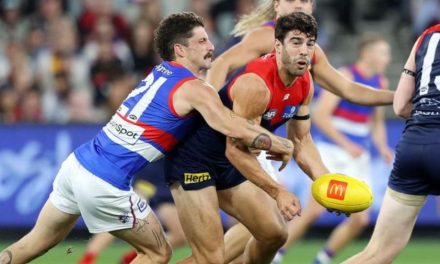Carlton’s Harry McKay could have easily joined Josh Bruce with 10 goals or more on the weekend. Photo: AFL MEDIA
Most football fans of my vintage, or even a bit younger, harbour a particular fondness for the year of 1993 as a popular highpoint for AFL football.
It’s the subject of a terrific podcast series “The Greatest Season That Was”, and it’s been cited several times already this season in terms of the exciting young Sydney line-up which has captured attention, the analogy drawn with 1993’s eventual shock premier, Essendon and its “Baby Bombers”.
The other obvious link between then is goals. Mind you, that’s all relative, as becomes obvious when you compare the leading exponents of kicking them in 1993 and 2021.
Back then, the names were Tony Lockett, Jason Dunstall, Gary Ablett snr, Tony Modra and Peter Sumich. Currently, we’re talking about Taylor Walker, Josh Bruce and Harry McKay. Bit of a difference.
We’re never again going to see a group as talented or as prolific as the former going around at the same time. But let’s be honest, given the alarming drop-off in scoring in recent years, it’s great to be talking about any player booting a bag of goals, let alone the double-figure haul Bruce managed for the Western Bulldogs on Good Friday.
So are (comparatively) higher goal tallies here to stay? Are they a direct result of the latest much-discussed rule changes? And could we potentially again see a player reach the 100-goal mark in a season?
My immediate answers to those questions are: (a) Still too early to say; (b) Certainly in part, but perhaps not completely; and (c) Doubtful, but not impossible.
Early season football is notorious for throwing up the odd mirage about scoring and openness of play due to firmer grounds and friendlier conditions, plus match hardness and defensive systems still being tweaked and finetuned.
This year, it’s also about coaches adjusting to the full ramifications of the new rules, and those adjustments being far more about countering opponents’ capacities to exploit them than finding further ways of doing so themselves.
Easter Monday’s pretty dour and defensive (until the last quarter) hit-out between Geelong and Hawthorn might have been some early evidence that is starting to happen. Round three was also marginally lower-scoring than the opening fortnight, with six teams held to less than 70 points.
And while the average score per team so far after three rounds at 85.6 is up on the 82.7 we had to the same stage of 2019 (leaving out last year’s adjusted game lengths), it’s still comfortably below 2016 (93.4), 2017 (95.6) and 2018 (90.4).
Maybe key forwards will have to make hay while the sun shines (literally), Walker is certainly doing his bit with 17 goals in three games. But that there are at least more opportunities afoot for the goalkickers so far in 2021 cannot be questioned.
PLEASE HELP US CONTINUE TO THRIVE BY BECOMING AN OFFICIAL FOOTYOLOGY PATRON. JUST CLICK THIS LINK.
Inside-50 numbers are currently at an average of 54.1 per team per game, the highest since 2000. There have been 171 marks taken on a forward-50 lead so far this season. In 2019 after three rounds, that figure was only 131. That’s a more-than-30-per-cent increase. And the retention rate for kicks inside 50 is higher than it’s been since 2016.
As for disposals per marks inside 50, that current figure of 30.55 is lower (and if you’re confused, lower is good) than any season since 2010. It’s significantly lower than the 35.16 to which it crept in 2020.
Is it all about the man-on-the-mark rule and 15 fewer rotations per game? Predominantly, but I also tend to think there’s at least a happy convergence of events, with coaches perhaps finally having decided the defensive ethos has gone about as far as it can.
So if defence can’t be made any more stingy than it has become, what alternative route to victory is there other than improving offence?
It’s not like key forwards have lost their tricks of the trade in recent years, it’s been all about being denied enough opportunity to use them. Now there’s enough glimpses of opportunity to make scoring, through the agency of well-equipped, strong-marking targets, at least a more enticing proposition.
Six players are currently averaging at least four marks inside 50 per game this season. The last player to record even four over an entire season was Josh Kennedy in 2015, and there’s never been multiple players do so.
Similarly, only once in the past 11 seasons (Kennedy and Jack Riewoldt in 2014) has more than one player kicked a bag of 10 or more goals in a game. Were it not for McKay’s wonky kicking (7.5) against Fremantle on Sunday, it would have already happened twice this year.
Again, you can’t argue the opportunities existed. The Western Bulldogs, in their belting of North Melbourne, were taking an inside 50 mark every 18 disposals on average, a ridiculous number. Carlton was doing so against the Dockers every 21.4 touches on average.
Imagine the sort of scoreboard damage, “Plugger”, “Gazza” and co. would have been doing in those circumstances, and especially given how much less tolerance there is now compared to 1993 for defenders holding on, pushing and scragging? Bob Pratt and Peter Hudson’s 150 goals in a season might really have been in trouble.
That’s not to say that Walker, Bruce, McKay and who knows which other key forwards can’t kick the sort of numbers we were beginning to think no longer possible. And you only had to hear the significant rise in crowd volume any time any of that trio went near the ball over the holiday weekend to know that it’s a prospect of which fans are very much in favour.
It still might be a long way short of comparisons to 1993. But given the sort of goalkicking famine we’ve endured for too long, this comparative feast of late is pretty damn enjoyable.
This article first appeared at ESPN.












For me, people overreacted to 2020. Of course last year was going to be low scoring. The defences weren’t going to get tired after 16 minutes, and it was less time to score in general. We still had an interesting finals series.